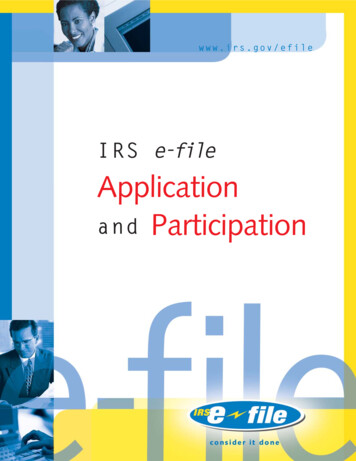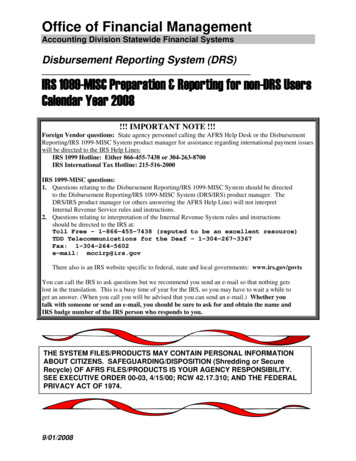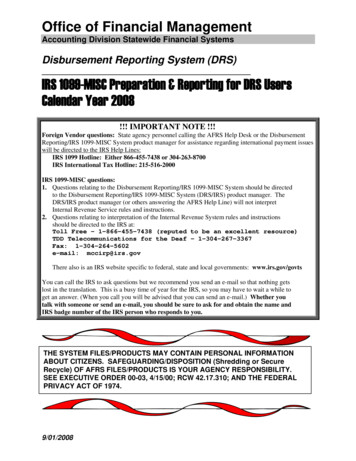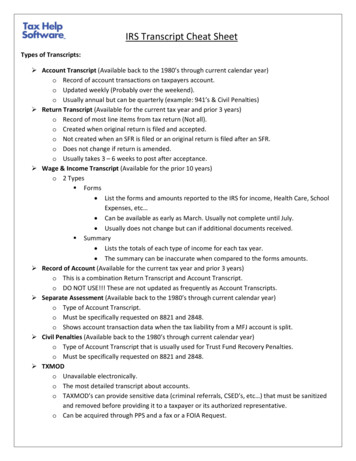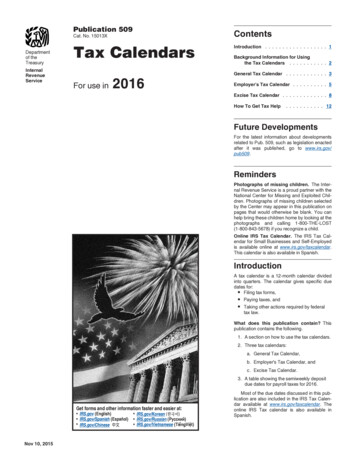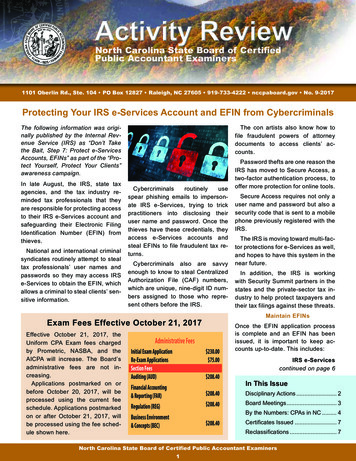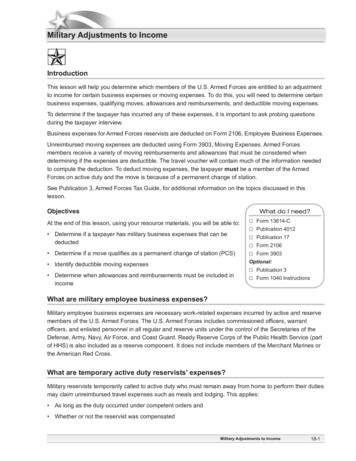
Transcription
Military Adjustments to IncomeIntroductionThis lesson will help you determine which members of the U.S. Armed Forces are entitled to an adjustmentto income for certain business expenses or moving expenses. To do this, you will need to determine certainbusiness expenses, qualifying moves, allowances and reimbursements, and deductible moving expenses.To determine if the taxpayer has incurred any of these expenses, it is important to ask probing questionsduring the taxpayer interview.Business expenses for Armed Forces reservists are deducted on Form 2106, Employee Business Expenses.Unreimbursed moving expenses are deducted using Form 3903, Moving Expenses. Armed Forcesmembers receive a variety of moving reimbursements and allowances that must be considered whendetermining if the expenses are deductible. The travel voucher will contain much of the information neededto compute the deduction. To deduct moving expenses, the taxpayer must be a member of the ArmedForces on active duty and the move is because of a permanent change of station.See Publication 3, Armed Forces Tax Guide, for additional information on the topics discussed in thislesson.ObjectivesWhat do I need?At the end of this lesson, using your resource materials, you will be able to: Determine if a taxpayer has military business expenses that can bededucted Determine if a move qualifies as a permanent change of station (PCS) Form 13614-CPublication 4012Publication 17Form 2106Form 3903Optional: Identify deductible moving expenses Determine when allowances and reimbursements must be included inincome Publication 3Form 1040 InstructionsWhat are military employee business expenses?Military employee business expenses are necessary work-related expenses incurred by active and reservemembers of the U.S. Armed Forces. The U.S. Armed Forces includes commissioned officers, warrantofficers, and enlisted personnel in all regular and reserve units under the control of the Secretaries of theDefense, Army, Navy, Air Force, and Coast Guard. Ready Reserve Corps of the Public Health Service (partof HHS) is also included as a reserve component. It does not include members of the Merchant Marines orthe American Red Cross.What are temporary active duty reservists’ expenses?Military reservists temporarily called to active duty who must remain away from home to perform their dutiesmay claim unreimbursed travel expenses such as meals and lodging. This applies: As long as the duty occurred under competent orders and Whether or not the reservist was compensatedMilitary Adjustments to Income18-1
To claim unreimbursed travel expenses, reservists must be stationed away from the general area of theirjob or business and return to their regular jobs once released. Expenses are deductible only if the reservistspay for meals and lodging at their official military post and only to the extent the expenses exceed BasicAllowance for Housing (BAH) and Basic Allowance for Subsistence (BAS). This includes any reimbursementreported under Code L in Box 12 of Form W-2.What is the 100-mile rule for reservists?Military reservists who must travel more than 100 miles away from home and stay overnight to attend a drillor reserve meeting may be able to deduct their travel expenses as an adjustment to income. The amount ofexpenses that can be deducted is limited to the: Federal rate for per diem (for lodging, meals, and incidental expenses) Standard mileage rate (for car expenses) plus any parking fees, ferry fees, and/or tollsexampleMary is in the Army Reserve. She lives in a town that is 120 miles from Base A, where she normallyreports for reserve drills or meetings. During the current tax year, she occasionally traveled to Base B,which was only 40 miles from her home. Mary can claim the travel expenses she incurred going to BaseA as an adjustment to income. She cannot claim the expenses for Base B as an adjustment.What is a permanent change of station?Moving expenses incurred as a result of a permanent change of station (PCS) are deductible only.A permanent change of station includes a move from: Home to the area of the first post of duty. One permanent post of duty to another. The last post of duty to home or to a nearer point in the U.S. The Armed Forces member must movewithin one year of ending active duty or within the period allowed under the Joint Travel Regulations.What does a permanent change of station include for spouses and dependents?If the Armed Forces moves service members and their spouses or dependents to or from separatelocations, the moves are treated as a single move and the qualified expenses of both moves are combinedand deducted on the same tax return.EXERCISESAnswers are at the end of the lesson summary.Question 1: Which of the following is a permanent change of station?A. A move by an Air Force pilot to an airbase for a six-month detailB. A move by an Army sergeant to his home two years after he ended active dutyC. A move by a new enlistee from her home to her first post of dutyD. A temporary move by a U.S. Marine to attend a six-month training program18-2Military Adjustments to Income
What expenses are included in the moving expense adjustment?Qualifying military moving expenses fall into the following two categories, the cost of: Moving household goods and personal effects Reasonable travel and lodging expensesTo qualify as “reasonable,” the route taken must be the shortest, most direct route available, from the formerhome to the new home. Additional expenses for stopovers, side trips, or pre-move house hunting expensesare not deductible as moving expenses.Qualifying expenses that exceed government allowances and reimbursements are deductible.How do I handle military reimbursements?Determine whether any moving allowances or reimbursements provided by the government should beincluded in a service member’s income, and how to accurately report the deduction on Form 1040.What is a Personally Procured Move (PPM)?Typically, Armed Forces members move their own household items in a personal or rented vehicle; this iscalled a Personally Procured Move (PPM), formerly known as a Do-It-Yourself (DITY) move. The ArmedForces provides an incentive payment equal to 95% of the estimated cost to the government for PPM.When the move is completed, the Armed Forces member provides receipts and paperwork to substantiateauthorized expenses. The net financial profit is taxable and is reported on a separate Form W-2.How do I report a PPM?PPM payments are reported on Form W-2 and are entered as wages on Form 1040.Armed Forces members may not take a moving expense deduction based on the expenses approved bythe finance office when settling the PPM, as they have already been used to reduce taxable income.exampleCaptain Cook receives orders for a PCS. He chooses to pack and drive his household goods to the newduty station in his own vehicle. The Air Force estimates that the move would have cost the government 2,500. Captain Cook’s actual expenses for the move were 1,750. He receives a payment for 2,375(95% of the government’s estimate), but Form W-2, Box 1, will show only 625 ( 2,375 minus 1,750)for the PPM. Captain Cook cannot deduct any of his expenses, since he’s already been reimbursed.What forms of reimbursement are not included as income?Certain forms of reimbursement provided by the government are not to be included as income on the ArmedForces member’s tax return. Moving or storage services furnished to the Armed Forces member Nontaxable allowances such as:– Dislocation allowance– Temporary lodging allowance– Mileage allowance in lieu of transportation– Per diem allowance– Move-in housing allowance (MIHA)Military Adjustments to Income18-3
EXERCISES (continued)Question 2: Sgt. Bishop received Form W-2 for 1,000 as a result of a PPM to a new Permanent DutyStation (PDS). In addition, the government paid her a mileage allowance of 300, a lodging allowanceof 200, and a dislocation allowance of 1,200. How much should Sgt. Bishop include in her wages onForm 1040?A. 1,500B. 1,000C. 300D. 200How do I calculate the adjustment?Deductions can only be claimed for expenses not covered by a nontaxable reimbursement or movingallowance. If the taxpayers have allowable expenses that exceed the amount they were reimbursed, Form3903 should be completed. Form 3903 is not needed if all the taxpayers’ reimbursements were nontaxableallowances that were greater than their expenses.Tax Software Hint: The tax software addresses the Armed Forces PCS move and calculates thestandard mileage amount based on miles traveled for the move. The instructions to Form 3903 specify thestandard mileage rate to be used each year.Taxpayer Interview and Tax Law ApplicationHere’s how a volunteer could help Mrs. Fannin determine if she had any deductible moving expenses:SAMPLE INTERVIEW.VOLUNTEER SAYS MRS. FANNIN RESPONDS You said you just moved here during June of this year.Was this a PCS move?Yes, my husband was transferred here inMarch, shortly before he deployed. I havefamily close by, so I’d rather stay here whilehe’s overseas.If your expenses were more than the Armed Forcesreimbursement, you may be able to use the differenceto reduce your gross income. We’ll complete Form3903 to see how it comes out. Did you bring your travelvoucher with you?It’s right here. We drove our own car 1,000miles to get here, and paid 120 for gas. Wepaid 300 for motels and 135 for meals on theway. The military moved our household goods,and we didn’t have any overweight.Did you drive directly here, or did you take anyside trips?We came right here so we could settle in beforehe deployed.18-4Military Adjustments to Income
SAMPLE INTERVIEW.VOLUNTEER SAYS MRS. FANNIN RESPONDS The IRS will let you use the standard mileage ratefor a military move. To determine the standardmileage rate, let’s look at Publication 3 and multiplythe rate times the number of miles.Okay.The IRS allows lodging costs, but not food. So yourtotal allowable expenses includes 300 for the motelsand your mileage expenses. The travel vouchershows a total of 400 in reimbursements – did youreceive any other reimbursements or allowances?No, that’s it.Then you’ll get to deduct the amount you spent thatwas more than your reimbursement.[On the intake and interview sheet, be sure to note thatyou’ve addressed this adjustment.]When should an Armed Forces member claim the deduction?Armed Forces members who use the cash method of accounting (the most common) and have qualifiedexpenses exceeding their reimbursement can deduct the expenses either in the year they paid them or inthe year reimbursement was received. If taxpayers choose to deduct their moving expenses in the year ofreimbursement, they can deduct: Expenses paid in a year before the year of reimbursement, or Expenses paid in the year immediately after the year of reimbursement but by the due date, includingextensions, for filing the return for the reimbursement year.If expenses are deducted and reimbursement is received in a later year, the reimbursement must beincluded in income.EXERCISES (continued)Question 3: In November of the current year, Petty Officer Wharton moved from California toWashington. The move qualified as a PCS. He incurred 800 in mileage expenses and 1,600 in lodging. He paid 1,400 to ship household goods over the allowed weight limit, and 500 to ship his dog.The following year, he filed his travel voucher and received 2,400 mileage and travel allowance. Healso received a 1,500 dislocation allowance.For what tax year(s) can Petty Officer Wharton claim his moving expenses on Form 3903?A. Next year onlyB. Current year onlyC. Either current year or next yearTaxpayer Interview and Tax Law ApplicationAmanda was relocated to another Air Force base. Here’s how a volunteer could help Amanda determine ifshe had any deductible moving expenses:Military Adjustments to Income18-5
SAMPLE INTERVIEW.VOLUNTEER SAYS AMANDA RESPONDS So, you were transferred from Maxwell Air Force Base to ScottAir Force Base last year, right?Yes, I was reimbursed 400 for travelexpenses on the way to Scott AirForce Base.Did you receive any other allowances?Yes, I also received a 1,000dislocation allowance.Well the reimbursements were not reported on your W-2. Youcan only deduct expenses that are larger than your combinedreimbursements and allowances. First, let’s add all your qualifiedexpenses. How much was your travel and lodging?I spent 575 on travel and lodgingand another 200 for meals along theway.Any other expenses?Yes, I gave a 350 security deposit tomy new landlord.Only the travel and lodging en route can be claimed on Form3903. The security deposit and meals are not deductibleexpenses. Your reimbursement and dislocation allowances addup to 1,400. Since that’s more than your expenses, you don’thave anything to deduct. But, you don’t have to include any ofthe excess reimbursement as income, either.SummaryThis lesson described the types of expenses that members of the Armed Forces can deduct as anadjustment to income. These expenses are deductible on Form 1040, Schedule 1.TAX LAW APPLICATIONTo gain a better understanding of the tax law, complete the practice returns(s) for your course of studyusing the Practice Lab on L<.You may not be able to complete the entire exercise if some of the technical issues in the exercise arenot covered until later lessons. In these instances, complete as much of the exercise as you can. Comeback later to finish the exercise after you cover all the technical topics.EXERCISE ANSWERSAnswer 1: C. A move by a new enlistee from her home to her first post of duty is considered a PCS.Answer 2: B. The 1,000 PPM payment should be included as wages. However, nontaxable allowances such as dislocation allowances, temporary lodging allowances and mileage allowances providedby the Armed Forces should not be included as gross income on the service member’s tax return, evenif they exceed allowable expenses.Answer 3: C. Because Petty Officer Wharton paid for moving expenses in the year prior to the year ofreimbursement, he can claim all of his moving expenses on Form 3903 in either the year he paid or theyear he was reimbursed.18-6Military Adjustments to Income
Unreimbursed moving expenses are deducted using Form 3903, Moving Expenses. Armed Forces members receive a variety of moving reimbursements and allowances that must be considered when determining if the expenses are deductible. The travel voucher will contain much of the information needed to compute the deduction.




